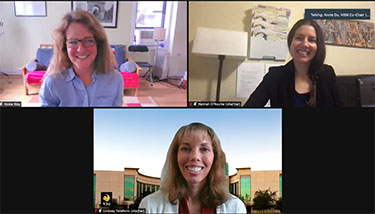The APHA 2021 theme of social connectedness was top of mind at today’s annual National Student Meeting, where public health students from across the country discussed social isolation and loneliness during the pandemic.
 During the virtual meeting, hosted by APHA’s Student Assembly, three researchers presented their work during a panel on “Social Connection and Support During Times of COVID-19 and Beyond.” Lindsay Taliaferro, an assistant professor of medicine at the University of Central Florida, focused on the suicide risks of LGBTQ adolescents.
During the virtual meeting, hosted by APHA’s Student Assembly, three researchers presented their work during a panel on “Social Connection and Support During Times of COVID-19 and Beyond.” Lindsay Taliaferro, an assistant professor of medicine at the University of Central Florida, focused on the suicide risks of LGBTQ adolescents.
Transgender students are four times more likely to consider suicide and more than six times more likely to attempt suicide, compared with cisgender students, according to national data from the 2017 Youth Risk Behavior Survey. Taliaferro pointed out the survey does not yet include a question about gender identity; the data are from the 10 states and nine large urban school districts that included a gender identity question on their state-specific surveys.
“It’s very important to note that these disparities…are linked to stressors and discrimination associated with being in a socially marginalized group in this country — not because they’re identifying as LGBTQ,” Taliaferro told student meeting attendees.
Research has shown that protective factors that reduce suicide risk among LGBTQ youth all relate to a sense of connectedness and support, she said. In fact, a 2019 Trevor Project survey found that LGBTQ youth who reported having at least one accepting adult in their lives were 40% less likely to attempt suicide within the past year.
However, during the pandemic, some LGBTQ youth likely faced decreased access to their support systems. Students who were quarantining with nonsupportive family members may have experienced an increase in rejection, ridicule and victimization, Taliaferro said.
“They may have had reduced access to LGBTQ-friendly and gender-affirming care, as well as have become isolated from their affirming and supportive friends and community networks,” she said. “Unlike heterosexual and cisgender adolescents, LGBTQ adolescents may have fewer alternatives for social support, so we need to make sure that those that they have are with them — and they might not have been during social distancing.”
A 2021 Trevor Project survey of LGBTQ youth during the pandemic found that more than 80% said COVID-19 made their living situations more stressful. Seventy percent said their mental health was poor always or most of the time. Furthermore, nearly half said the pandemic negatively affected their ability to express their sexual orientation, while 60% said the same about their gender identity. The highest percentages were among the youngest teenagers and Black and Hispanic youth.
Research shows that a positive sense of identity is critical for mental health, but these recent surveys underscore that physical distancing and quarantining didn’t allow some LGBTQ adolescents to live and embrace their true selves during the pandemic, Taliaferro said.
“We need to ensure that all LGBTQ youth know they’re not alone and that they feel encouraged to seek the support and affirming social connections that they need,” she said.
Photo of presenters Niobe Way, Hannah O'Rourke and Lindsay Taliaferro by Melanie Padgett Powers